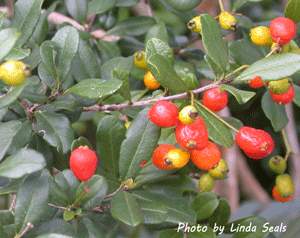If you are wondering how you can contribute to healing the Indian River Lagoon, I recommend starting with your lawn. So whether your lawn is beach side or landlocked…formal or informal…Simpson’s Stopper (Myrcianthes fragrans) is the perfect plant for Brevard County lawns. It is versatile, and can be trained to be a small tree or allowed to grow naturally as a shrub. It is not too picky about where it is planted, which can’t be said for many native plants (or non-native plants). Its fragrant flowers are attractive to bees and butterflies, and birds love the fruit. It’s drought and salt tolerant, and relatively pest-free.

Where to plant
Simpson’s Stopper can be planted in full sun or shade. Plants in full sun grow denser foliage, and this makes them perfect for screening, hedges, and shrub borders. In shade, the foliage is less dense, but the beautiful bark is revealed. Train it to grow as a small multi-trunked tree, and plant near a patio or deck to provide shade. If interested in training a Simpson’s Stopper into a tree form, contact a Master Gardener to learn how to do this correctly without harming the tree.
Stoppers can reach 20-30 feet tall when mature, but they are very slow growers, so it will be many years before yours will reach those heights. Nevertheless, be sure to place the plant far enough away from structures—especially powerlines and soffits–to avoid problems in the future.

Planting your tree
Simpson’s Stopper is perfectly content with sandy soils, even those containing lots of shells. Be sure to purchase healthy plants (buy the biggest plant you can afford), and plant them correctly. A Master Gardener can explain how to correctly install a shrub or tree, or you can visit http://hort.ifas.ufl.edu/woody/planting.shtml for guidance.
You should water your plant frequently until it is established. Establishment takes about six months to a year depending on soil temperatures. Once established, regular rainfall will be sufficient to keep Simpson’s Stopper happy.
Don’t bother fertilizing, unless your plant shows signs of nutrient deficiency. If you can’t tell the difference between nutrient deficiency and pest problems, call our Master Gardeners. They can help accurately identify the problem and prescribe the right solution.
Simpson’s Stopper is the perfect native plant for beginners, beachgoers, native enthusiasts, butterfly gardeners, and nature lovers…you name it! Visit one of Brevard County’s local garden centers or nurseries and start planting!
 0
0
